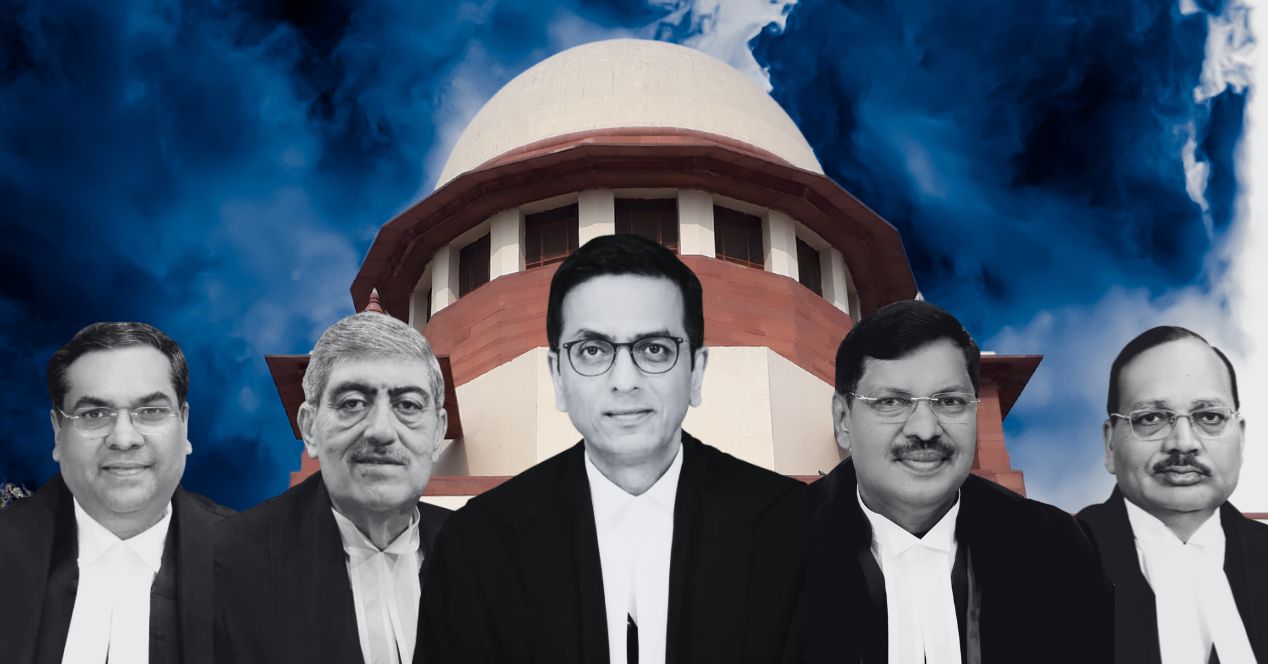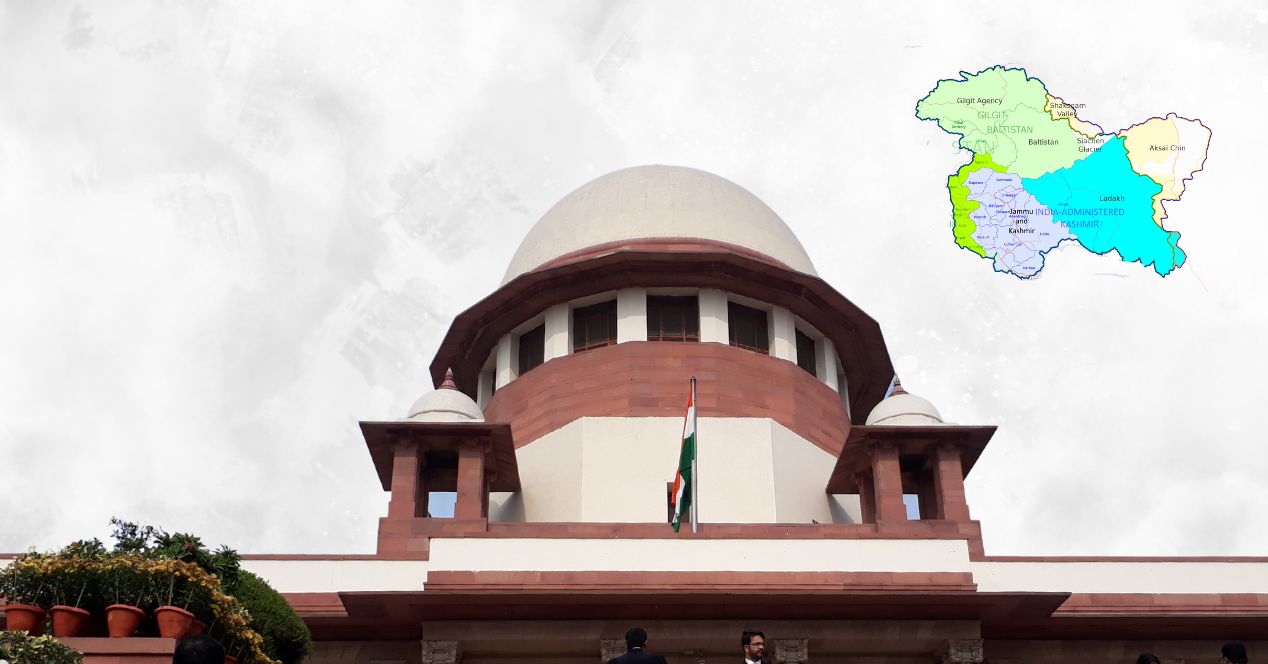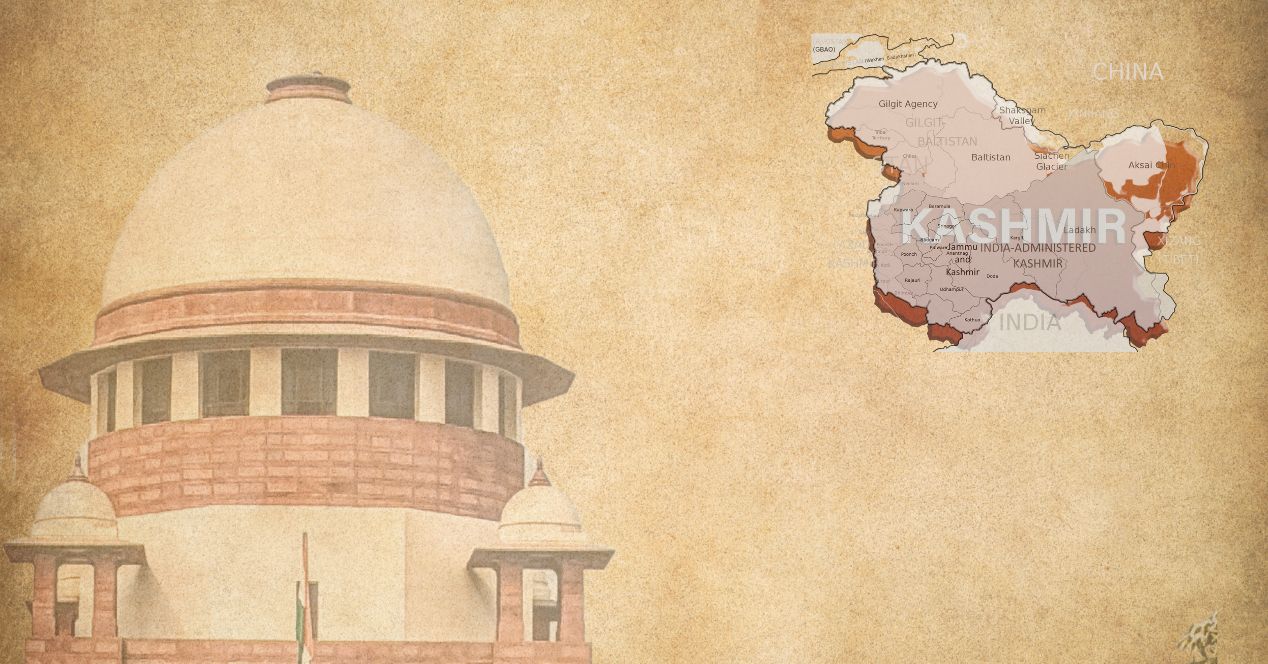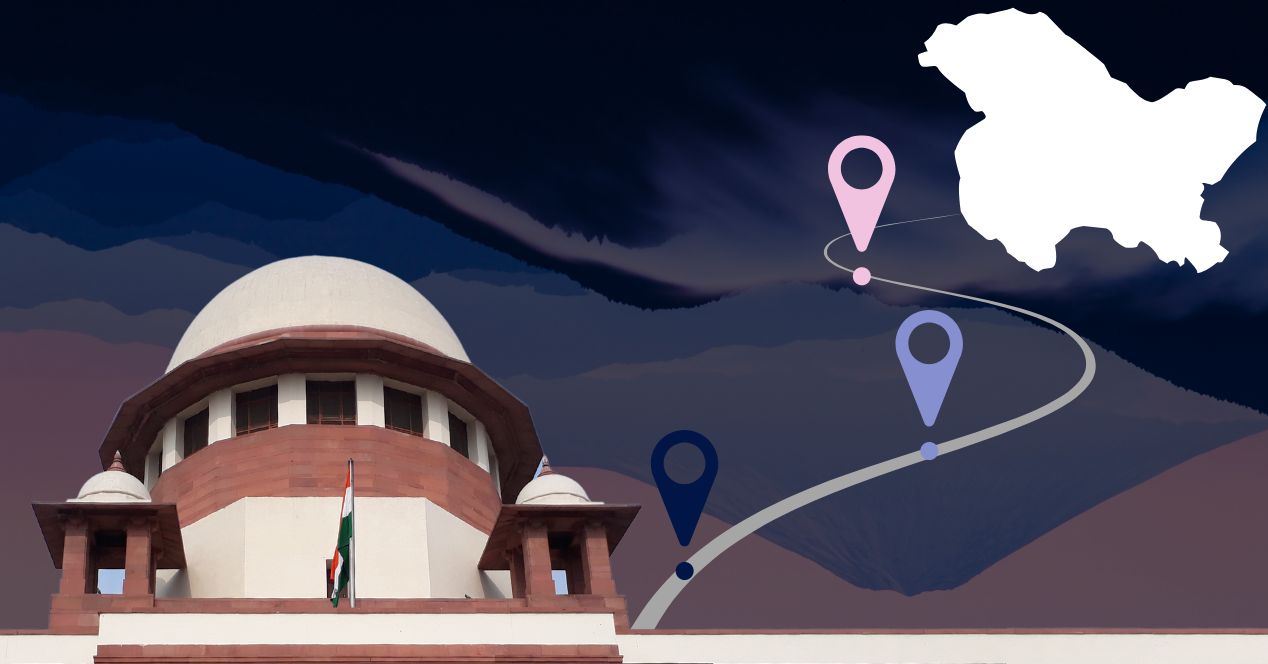Abrogation of Article 370 | Day 3: Executive Decisions Cannot Permanently Alter the Constitution
Challenge to the Abrogation of Article 370Judges: D.Y. Chandrachud CJI, S.K. Kaul J, Sanjiv Khanna CJI, B.R. Gavai J, Surya Kant J
Today, Senior Advocate Kapil Sibal concluded his arguments after 3 days of hearing. He submitted that Article 370 could not be repealed through executive actions.
Last week, Sibal submitted the the abrogation was unconstitutional as Parliament has assumed the role of Jammu and Kashmir’s ‘Constituent Assembly’ to do so.
Background
Article 370 of the Constitution of India provided the State of Jammu and Kashmir with a special constitutional status. The provision substantially limited Parliament’s power to legislate for the State compared to other states.
On August 5, 2019, the Union government diluted Article 370, revoking Jammu and Kashmir’s special status. First, President Ram Nath Kovind issued presidential order CO 272. This Order allowed the Union to amend Article 370 without the recommendation of the Constituent Assembly.
Since J&K was under President’s Rule at the time, the powers of the Jammu and Kashmir Legislative Assembly were vested in the Union Parliament. So, a few hours after CO 272 was issued, the Rajya Sabha recommended the abrogation of Article 370 through a Statutory Resolution under Article 370(3).
On August 6, 2019, President Kovind issued a Proclamation, CO 273, putting the Rajya Sabha’s recommendation into effect. All clauses of Article 370 ceased to operate, except Clause 1 which was amended to state that the Constitution of India applies wholly to the State, removing the special status awarded to Jammu and Kashmir.
On August 9, Parliament passed the Jammu and Kashmir Reorganisation Act, 2019. This Act bifurcated the State of Jammu and Kashmir into two Union Territories—J&K and Ladakh.
Petitions were filed challenging the constitutionality of the dilution of Article 370 and the bifurcation of the State into two Union Territories.
On August 28, 2019, a 3-Judge Bench led by former CJI Rajan Gogoi referred the case to a 5-Judge Constitution Bench.
On October 1, 2019, 5-Judge Constitution Bench of the Court comprising Justice N.V. Ramana, S.K. Kaul, R. Subhash Reddy, B.R. Gavai and Surya Kant decided to hear the case from November 14th, 2013. The petitioners sought the case to be placed before a larger Bench. On March 2nd, 2020, the Bench refused to refer it to a larger Bench.
On July 3, 2023, the Supreme Court listed the matter to a Constitution Bench led by Chief Justice D.Y. Chandrachud. The Bench assembled on July 11, 2023 and decided to hear the challenge from August 2, 2023.
A Constitutional Framework Cannot Be Altered by an Executive Order
Opening the day’s arguments Sibal read excerpts of speeches by Sheik Abdullah and Mir Kasim, to argue that ‘an executive act of the union of India cannot alter, unilaterally, provisions of the Constitution of India, as applicable to Jammu and Kashmir’.
Sibal argued that a constitutional relationship between India and Jammu and Kashmir was enshrined under Article 370 and could not be changed. However, the Union dissipated this relationship through two Presidential Orders in 2019. This was an executive action. Kashmir’s accession to India and the inclusion of Article 370 into the constitution were both political decisions. Therefore, Article 370 could only be abrogated through a political decision, which reflected the will of the people of Kashmir. Not through an executive order.
Is Article 370 Permanent Because the J&K Constituent Assembly Deemed it So?
Sibal repeated his arguments from August 3, 2023, that only Jammu and Kashmir’s Constituent assembly had the right to abrogate Article 370. They were vested with the task to create a Constitution for Jammu and Kashmir and had the opportunity to repeal the provision between 1951 and 1957. Their decision to retain the provision meant that Art. 370 was envisaged to be a permanent provision of the Constitution.
Unconvinced, Chief Justice D.Y. Chandrachud asked whether the J&K Constituent Assembly’s non-removal of Art. 370 was sufficient to make it a permanent provision. Did this decision have to be reflected in the Indian Constitution by some action of our Parliament? Sibal responded that no action was taken in India in contradiction to Article 370, which showed that the Constitution of India had accepted the permanent nature of this Provision.
Amendment of Article 367 was Unconstitutional
Sibal began to read out Presidential Order C.O. 272 of (2019) to establish that it created a ‘constitutional myth’. The Order stated that “references to the Government of said State shall be construed as including reference to the Governor of Jammu and Kashmir acting on the advice of his council of ministers”. Sibal pointed out that at this stage, there were no Council of Ministers in the State as it was under President’s rule and the Assembly was suspended.
He then brought the Court’s attention to Clause 2(d) which replaced ‘Constituent Assembly’ with ‘Legislative Assembly’, effectively allowing Parliament to recommend abrogation of Article 370. A visibly frustrated Sibal asked ‘What power does the President have to do this?” With this, he characterised the Presidential Order as an exercise of executive power rather than a Constitutionally recognised political one.
Sibal submitted that Article 367 was an ‘interpretation clause’ not a ‘substitution clause’. The Union could not use this to substitute the meaning of ‘constituent assembly’ to abrogate Article. 370. This was against the contours of Article 367 itself.
The Bench sought to understand why Article 367 was brought into the scheme of things in the first place. They theorised that at this stage, J&K was under Presidential Rule. Parliament had taken on the duties and powers of the Legislative Assembly, and could directly abrogate Article 370. Why then, was an amendment to Art. 367 needed? Sibal instantly took this opportunity to suggest that the Union’s actions betrayed a larger political scheme. He stated that the Union was aware that only the constituent assembly had the power to amend Article 370. To shift this power to the legislative assembly, they had to amend Article 367. By amending this provision through C.O. 272, the Union indirectly achieved what it could not achieve directly.
Values of Federalism, Democracy Must be at the Heart of Interpreting the Constitution
After lunch, Sibal attempted to persuade the Court to focus squarely on the relationship between the President’s powers under Art. 356 and the two Presidential Orders of 2019. In determining this relationship, he said, the Court must be guided by three key principles.
Waiting for the Bench to take notes of his points, Sibal slowly and deliberately said that first, the Court had to give effect to “the clear language of these provisions, in its structural and historical context”. Second, in case of any textual ambiguity, the Court must use an interpretation that is consistent with “constitutional values, federalism, representative democracy and constitutional morality”. Lastly, any power vested by or under the Constitution was not an unlimited power. It is “limited at the point in time when it is exercised and by core constitutional principles or values”.
If these guiding principles are applied, it is apparent that the power under 370(1) (d) does not permit the abrogation of Article 370. Further, the power under Article 356 does not extend to making non-restorative, permanent alterations to the State’s constitutional status. And finally, with these guidelines, it would be evident that the power under Art. 3 does not extend to effacing the character of a State to a Union territory.
With much conviction, Sibal asserted that these guiding principles proved that the Executive’s (President’s) powers were limited to the framework built by the Constitution. An Executive Order could not make permanent changes to the Constitution. Further, Constituent powers could not be equated with ordinary legislative powers. And finally, a State could not be downgraded to a Union Territory by a Union’s Order.
Key Judgments in Support of Sibal’s Arguments Against Abrogation of Article 370
Referring to precedents to support his argument, Sibal walked the Bench through a series of Supreme Court Judgements that clarified the scope and extent of Article 370. Based on S. R. Bommai v Union of India (1994), he argued that the Court had clearly held that the ‘exercise of powers vested under such provisions [Article 356] needs, therefore, to be circumscribed to maintain the fundamental constitutional balance lest the Constitution is defaced and destroyed’.
Moving on, Sibal referred to Prem Nath Kaul v The State Of Jammu & Kashmir (1959), where the Supreme Court held that “Constitution makers attached great importance to the final decision of the Constituent Assembly and the continuance of the exercise of powers conferred on the Parliament and the President by the relevant temporary provisions of Art. 370(1) is made conditional on the final approval by the said Constituent Assembly”
Sibal read excerpts from Sampat Prakash v State of Jammu & Kashmir, (1968) where the Supreme Court held that Article 370 would continue to exist even after the dissolution of J&K’s constituent assembly.
Lastly, in Maqbool Damnoo v State of Jammu and Kashmir (1972), the Court upheld a Presidential Order which changed the phrase ‘Sadar-i-riyaasat’ to mean ‘Governor’. Sibal insisted that the top Court upheld this Order only because it viewed the amendment as a mere clarification to a change in nomenclature, as the office of the ‘Sadar-i-Riyasat’ no longer existed. There was no alteration of the constitutional framework.
Sibal pleaded that the judgements of the top court in all these cases established the unique status of Jammu and Kashmir. They clarified that Article 370 could not be abrogated without the concurrence of the people of Kashmir.
The Union Cannot ‘Downgrade’ a State into a Union Territory
Sibal spent the last few minutes arguing that a State cannot be downgraded to a Union Territory by executive action. Article 3 stipulated that Union Territories could be formed by joining parts of two States, by increasing or diminishing the area of a State, or by altering the boundaries or the name of a State. However, a State could not be reduced or split into two Union Territories. He asserted that doing this was contrary to the ‘representative form of government’ and was impermissible.
He concluded his arguments with a passionate reminder that this was a ‘historic moment, not for the present, but for the future of India’ and urged the Bench to not be silent as the will of the people of Kashmir is under threat.
Senior Advocate Gopal Subramaniam will commence his arguments on behalf of the petitioners tomorrow August 9, 2023.




